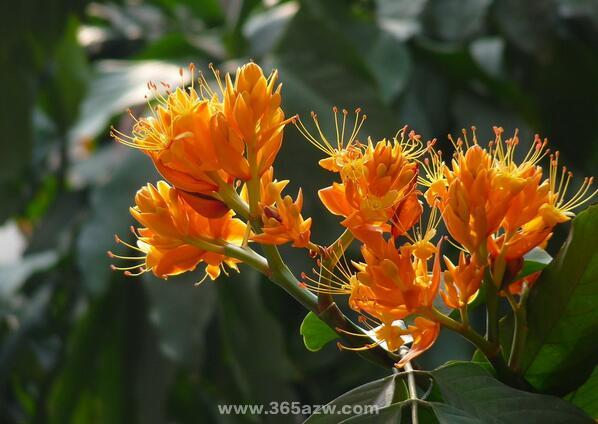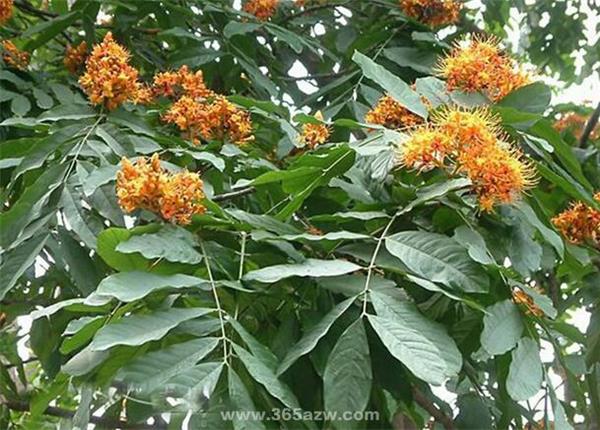Introduction to the method of worry-free tree culture
The worry-free tree is a special kind of tree in Buddhism. Many Buddhists think that this plant can eliminate sadness. Next, let's introduce how to cultivate this kind of tree.
A brief introduction to worry-free tree

A different tree in Buddhist legend, having pinnately compound leaves with a very soft petiole that cannot support the leaves, so that the tender leaves are drooping, looking like a purple cassock wet by rain. It blossoms every year from March to May, with flowers everywhere on the trunk or twigs. The torch-like golden inflorescence covers the whole crown of the tree, overlooking like a golden pagoda.
The flower of the worry-free tree, which looks like a four-piece flower, is actually a calyx, which has been degraded. The leaves are three to six pairs of pinnately compound leaves, the edges of each leaflet are wavy, ten to sixteen meters long and three to four meters wide. The new leaves are soft and drooping when they bloom, showing a beautiful red color. The seeds mature in autumn.
Hinduism believes that a worry-free tree is a sacred tree. For example, one of the five arrows in the hand of Kama, the god of love, is made of a worry-free tree. People believe that this kind of tree can eliminate sadness, so it is called a worry-free tree.
In addition, the Shu Zhen Jia Shu mentioned in the Buddhist sutra is also considered to be a synonym for the worry-free tree.

Worry-free tree related culture
Prince Norodom Sihanouk, President of Democratic Cambodia, and his wife, Princess Monique Sihanouk, personally planted the worry-free tree on January 17, 1986. It is said that there was continuous war in Cambodia at that time, and the people were living in dire straits. Prince Sihanouk planted this worry-free tree in order to place his hope that the Cambodian people can live and work in peace and contentment and lead a carefree life.
Worry-free tree is a kind of beautiful flowers and trees, its flowers are red, when in full bloom, such as flames, dizzying, suitable for the main landscape, avenues and urban street trees, is a combination of greening, beautification, color garden tree species. It can also be widely used in the green planting of the courtyard.
Cultivation techniques of worry-free trees
Seed breeding
Seeds are commonly used to sow and raise seedlings. A thousand seeds weigh about 400 grams. The seed coat is difficult to absorb water. It is necessary to use 80 ℃ warm water to scald the seed to promote germination. After natural cooling, continue to soak for 24 hours and drain. When sowing by strip sowing, the seedlings are sensitive to frost, comprehensive fertilizer can be applied in the early stage, less nitrogen fertilizer can be applied, and fertilization should be stopped after autumn to promote Lignification as soon as possible.
The 2-year-old seedlings can be planted in the field when the height of the 2-year-old seedlings is 50m / m and 60m / kg. If the planting site is slightly acidic, it is appropriate to apply lime in layers during soil preparation to neutralize the acidity. Rotten barnyard manure or sifted garbage should be used as base fertilizer before planting. After planting, it should be fully watered and props should be set up. During the peak growth period in spring and summer, nitrogen fertilizer should be applied once a month, and after autumn, fertilizer should be stopped to help seedlings survive the winter and prevent cold. After the trunk is formed, pay attention to pruning and shaping, properly control its growth, in order to cultivate a beautiful crown. Cultivate 3Mel-4-year-old seedlings, which can be used in landscaping, with few diseases and insect pests. Pruning once after flowering, but not re-pruning or strong pruning, keep the old branches to blossom the following year.

Reproduction method
Propagation should be carried out in spring by cutting method, sowing method or high pressure method.
Commonly used to sow and reproduce. Seeds mature in August, avoid sun exposure and composting, should be sowed as they are picked, and are not resistant to storage. If the sand is stored wet, the germination power can be maintained for half a year. The suitable time for sowing is from spring to summer, and the optimum temperature for seed germination is 24 Murray 28 degrees Celsius. The seedlings began to germinate in late September. After germination, the seedlings overwintered in the sand bed, should pay attention to cold prevention, and then moved the seedlings after the next spring.

The above is the introduction of worry-free tree culture. I hope it will be helpful to you.
Related
- Wuhan Hospital Iron Tree Blooming Result Was Instantly Frightened by the Gardener Master
- Which variety of camellia is the most fragrant and best? Which one do you like best?
- What is the small blue coat, the breeding methods and matters needing attention of the succulent plant
- Dormancy time and maintenance management of succulent plants during dormancy
- Minas succulent how to raise, Minas succulent plant pictures
- What are the varieties of winter succulent plants
- How to raise succulent plants in twelve rolls? let's take a look at some experience of breeding twelve rolls.
- Attention should be paid to water control for succulent plants during dormant period (winter and summer)
- Watering experience of twelve rolls of succulent plants
- Techniques for fertilizing succulent plants. An article will let you know how to fertilize succulent plants.



